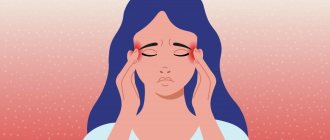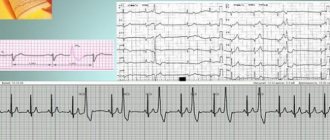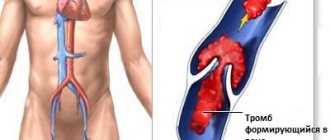Manifestations of headache and accompanying symptoms
We call any pain in the head area a headache, but the mechanism of its occurrence varies. It is caused by irritation of pain receptors in the dura mater, as well as blood vessels, nerves - trigeminal, glossopharyngeal, vagus, skin nerves, head muscles, cervical spinal roots. It can also manifest itself in different ways: it can be dull, pulsating, squeezing, bursting; can concentrate in the forehead, temples (on one or both sides), back of the head, crown of the head. Attacks can be strong, moderate or weak, and vary in duration and frequency. Pain may be accompanied by other symptoms (nausea, vomiting, visual disturbances, dizziness, increased or decreased blood pressure, etc.). All these characteristics are important for making a diagnosis.
Causes of headaches
There are primary and secondary headaches. Primary pain is considered to be pain that is not an accompanying symptom, but is an independent disease. In this case, it is the headache that is the main problem. Secondary headache is one of the manifestations of a disease that is not limited to headache. Severe headaches can be accompanied by infectious diseases and poisoning of various natures (both toxic substances entering the body from the outside and those produced inside the body, for example, toxins that are formed as a result of the activity of viruses and pathogenic microbes in the body). A headache can occur as a result of stress, weather changes, hypothermia or overheating of the body, lack of sleep, hunger, overeating, lack of oxygen - the cause can be anything that leads to disruption of the metabolism necessary for brain activity.
So, if you have a headache, it does not necessarily mean that you are sick: it may simply be the result of a random factor. However, if the headache occurs periodically or persists for a long time, then most likely there is some kind of disease. In 95% of such cases, there is a primary headache, and only in 5% of cases is it secondary.
Primary headache. Major diseases.
The most common forms of primary headache are “tension pain” and migraine, more rarely – cluster headache and other forms.
Tension headache (TTH)
can occur in anyone. This is the most common form of headache and is often characterized as a “normal” or “regular” headache. Attacks can last from 30 minutes to several days. The frequency of attacks varies from person to person, and it can also vary from one person to another during different periods of his life. The pain is described as squeezing, squeezing the head like a hoop or tight hat, usually bilateral, and moderate. In some people it can become chronic (chronic pain is diagnosed if there are more days with a headache than without it). A person experiencing chronic headaches becomes irritable. Weakness, fatigue, decreased appetite, and sleep disturbances may occur. The cause of TTH is physical tension in the muscles and ligaments of the head and neck - the so-called “muscle stress”, which can be a consequence, for example, of working in an uncomfortable position. TTH often occurs in those who work at a computer or whose work involves the need to look at details (jewelers, watchmakers, assemblers of electronic equipment, masters of artistic embroidery, etc.). The emotional factor is also important: emotional tension caused by stress or a state of increased anxiety can also lead to pain.
Migraine
characterized by severe and painful attacks of headache, which are often accompanied by nausea (and in some cases vomiting), as well as intolerance to light and sound. The perception of smells changes, thermal sensations are disrupted. Migraine attacks last from 4 hours to 3 days and can be repeated with a frequency of 1-2 times a year to several times a month. During an attack, so-called “precursors” may be observed - irritability, depression, fatigue, occurring several hours or even days before the onset of pain. In a third of cases, pain is preceded by phenomena called “auras”: 10-30 minutes before the attack there may be visual disturbances (blind spots, flashes, zigzag lines in front of the eyes), tingling and numbness starting from the fingertips and spreading up the body and etc.
Predisposition to migraine is congenital and is associated with disorders in the brain structures responsible for pain and other sensations. Every seventh adult suffers from migraines, with women three times more likely than men. In girls, migraines usually begin during puberty.
Factors that contribute to the development of migraine attacks: chronic fatigue, anxiety or stress, in women - menstruation, pregnancy and menopause.
But a predisposition to seizures does not mean that an attack will definitely happen. There are factors that act as a “trigger” for an attack. An attack can be triggered by: skipping meals, insufficient fluid intake, certain foods, sleep disturbances, physical activity, changes in weather, sudden changes in emotions.
Cluster (or beam) headache
characterized by one-sided sharp (“dagger” or “drilling”) pain. The intensity of the pain rapidly increases within 5-10 minutes, and the attack itself lasts from 15 minutes to 3 hours, during which the patient cannot find a place to rest. The pain is usually localized in the eye area, and the eye may become red and watery. Recurrent attacks form a cluster (that is, they follow each other), the duration of the cluster is from 6 to 12 weeks. This form of pain occurs five times more often in men than in women. However, those who smoke a lot or have smoked in the past are more susceptible to it.
Prevention methods
According to statistics, adults often have headaches due to acquired disorders. Common causes are poor diet, stress and lack of rest, and excess weight. Today, many people, including young people, lead a sedentary lifestyle, which also negatively affects the general condition of the body. Doctors at the Clinical Institute of the Brain have several tips on how to provide timely prevention of headaches at home:
- regularly measure blood pressure, especially at the age of 40 years or more;
- perform simple exercises for the neck and head every day, including during the working day;
- consume sufficient amounts of vitamins and microelements;
- give up bad habits, smoking and drinking alcohol, as well as fatty foods high in cholesterol.
If a person has a headache for several days or even weeks, it is worth contacting the Clinical Brain Institute. Doctors will develop an individual program for diagnosing and treating chronic pain. The scheme will include only the necessary informative techniques that will allow you to quickly make an accurate diagnosis and select the most effective course of treatment, including at home.
Secondary headache and diseases in which it occurs
In general, primary headache, although it disrupts the normal course of life during attacks, does not have serious consequences for a person’s general health. And secondary pain, despite the fact that it occurs much less frequently (in 5% of cases), can be a consequence of a dangerous disease.
Headache is necessarily present among the symptoms of the following diseases:
- vegetative-vascular dystonia (headaches can be combined with dizziness, nausea, fluctuations in blood pressure);
- hypertension (pain is mainly localized in the occipital region, there may be dizziness, noise in the head, spots before the eyes, heat in the head, pain in the heart);
- stroke;
- traumatic brain injury;
- meningitis;
- encephalitis;
- eye diseases (for example, glaucoma);
- diseases of the ear and nasopharynx (otitis media, sinusitis);
- neuralgia;
- diabetes;
- renal failure;
- oncological diseases.
Diagnostics
Patients who experience heaviness in the head require consultation with a neurologist. The specialist receives valuable information during the initial examination, determining the neurological status and conducting simple tests to assess autonomic innervation. During a conversation with the patient, the fact of dependence on alcohol or psychoactive substances can be revealed. Diagnosis of the causes of heaviness in the head involves the appointment of instrumental and laboratory methods, of which the most commonly used are:
- CNS study.
Standard examination in neurology includes echoEG, which is used to measure intracranial pressure and identify space-occupying pathological formations. To clarify the diagnosis, EEG, CT, and MRI of the brain are prescribed. REG and extracranial ultrasound data have diagnostic value. - X-ray of the spine.
Images of the cervical spine in two projections make it possible to determine bone deformation, narrowing of joint spaces, and developmental anomalies. Bones and neurovascular bundles are visualized in detail during either MRI. - ENT examination.
Heaviness in the head accompanied by dizziness requires a standard otoscopy and a hearing test using audiometry. For diagnostic purposes, specific tests are performed: acoustic impedance measurement, electrocochleography, vestibulometry. - ECG.
Unpleasant symptoms may be associated with cardiac problems, for rapid diagnosis of which electrocardiography is recommended. If abnormalities are detected on the cardiogram, the diagnosis is clarified using 24-hour blood pressure monitoring and echocardiography. - Blood analysis.
When heaviness in the head is combined with an increase in body temperature, it is necessary to examine the hemogram. The results of the analysis indicate an inflammatory process (leukocytosis and increased ESR), and also help diagnose polycythemia (with an increase in the number of red blood cells).
Massage of the cervical-collar area
When should you see a doctor for a headache?
Many people prefer to simply take popular painkillers and not see a doctor. However, self-medication can lead to excessive use of such drugs, which can cause gastritis, peptic ulcers, as well as chronic headaches caused by taking medications. In addition, without undergoing a medical examination, you may miss the development of a dangerous disease. And a momentary effect obtained with the help of a random drug will still not be a solution to your problem.
You should definitely consult a doctor:
- if pain occurs for the first time in life (especially important for people over 50 years old);
- with very severe headaches;
- if the pain continues for a significant time (more than a week);
- if the pain intensity increases over time;
- when a headache occurs or worsens after a change in position or sudden movement of the head;
- if there are cases of loss of consciousness, memory impairment, changes in personal qualities;
- if the pain does not go away after taking antipyretic and painkillers.
Treatment
Help before diagnosis
To eliminate heaviness in the head, a positive emotional attitude is of great importance. It is necessary to protect yourself as much as possible from stress and external irritants, normalize your daily routine, and not overwork yourself at work. Doctors advise establishing a drinking regime and limiting coffee consumption to 1 cup per day. Regular walking before bedtime, fortified meals, and a change of environment help reduce signs of neurasthenia.
Self-administration of painkillers to relieve heaviness and pain in the head is the wrong approach, since the symptoms manifest themselves in dozens of different diseases. Trying to eliminate discomfort, the patient does not solve the problem, so there is a risk of disease progression and complications. If heaviness in the head is accompanied by nausea and vomiting, visual and hearing impairment, this is an indication for emergency medical attention.
Conservative therapy
To eliminate heaviness in the head associated with tension cephalgia or neurasthenia, psychotropic medications are recommended. Antidepressants - selective serotonin and norepinephrine reuptake inhibitors - have a good effect. Additionally, muscle relaxants and sedatives are prescribed. To remove symptoms, restorative treatment is carried out with calcium glycerophosphate and hopantenic acid.
If the cervical spine is affected, tablets of non-steroidal anti-inflammatory drugs are taken, injections of chondroprotectors and B vitamins are given. To quickly relieve discomfort, ointments with an analgesic and warming effect are indicated. If the pathology is accompanied by vertebral artery syndrome, therapy is enhanced with neuroprotective drugs and medications that improve cerebral circulation.
For neurasthenic cephalgia and heaviness in the head, physiotherapeutic treatment is effective. Reflexology, aromatherapy, and electrosleep are effective in normalizing the functioning of the nervous system. To get rid of symptoms of cervical osteochondrosis, electrophoresis with drugs, magnetic therapy and electroanalgesia are used. ShVZ massage and manual therapy are performed strictly as prescribed by the doctor.
Which doctor should you see if you have a headache?
If you complain of a headache, you should first contact your physician. To make it easier for the doctor to understand your disease, it is advisable to prepare answers to the following questions before visiting the doctor:
- How long has the pain been present?
- How often do the attacks recur?
- How long do they last?
- How severe is your pain (mild, moderate, severe, intolerable)?
- What is its character (pressing, bursting, pulsating)?
- In what part of the head is the pain concentrated?
- Are there any accompanying symptoms and what are they?
- At what point does pain occur (what contributes to its occurrence)?
- Do you manage to relieve pain (prevent attacks) and how do you do it?
- Do your relatives have similar complaints?










